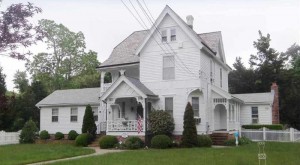When moving into a new home, there are always a thousand factors to take into consideration. But when you’re moving into an old home, there’s even more to keep in mind. Living in an older or historic house is a challenge you should be prepared for well before moving day.
What to Know
Whether you planned to live in a historic home or you just happened to fall in love with an old house, it’s important to know what you’re getting into before you pack up your first box. Many older homes simply cannot accommodate larger contemporary furniture.
“There’s the issue of what do I actually put where,” said Joe Copley, owner of OldHouses.com, said. “If you have a king-sized bed or want one, you’d better get your measuring tape out.”
King-sized beds, entertainment centers, and sectionals are all things that may be difficult to fit into certain older homes, so make sure you have a clear idea of how much space you have available; measure everything from door frames to hallways before lugging a too-big sleeper sofa across the country.
Older homes are often packed with stories, craftsmanship, and character. Unfortunately, this character and craftsmanship can also mean a lot of maintenance and upkeep – if you’re moving into an old house, plan for any number of fixes and projects.

Image from OldHouses.com
“With a historic home, light fixtures, hardware, doorknobs – all those things are going to be more expensive to fix if you want to do it the right way and keep it in the period it is,” Tim Cannan, founder of PreservationDirectory.com, said.
Cannan pointed out that the biggest shock for many first time old home owners will likely be the cost. “It’s like taking care of an old car – the parts are going to be more expensive and it’s going to be harder to find them.”
“If you’re going to do some work on the house, you need to take whatever time and money you estimate and multiply it by two and to be safe multiply it by three. It always costs more and takes more time than you think it’s going to take.”
– Joe Copley
The last major thing to keep in mind before moving into an older or historic home is the difference in design and architecture. Built before the days of Xeroxed home plans, older homes were made for a different lifestyle.
“I don’t think people are prepared for the way old houses are meant for living,” Copley said, “they’re designed for a lifestyle that had people in and out more.” This can mean old homes are more drafty and much less energy efficient.
How to Prepare
Now that you know what to expect from an old house, it’s important to have a plan before you move.
“I always recommend that people who buy old houses buy one with at least one more room than you really need,” Copley advised. “You’ll be moving stuff around from room to room – it’s great to have a room to stick all the furniture in while you’re working on another one.”
An extra room has numerous uses and in a home with potentially limited space, it’s a great idea to shop with extra space in mind.
When tackling the inevitable home improvement projects, both Copley and Cannan suggested finding help before you even load the moving truck.
“You’ll definitely want your neighbors around if you’re fixing up an old house,” Copley said.
Now may be a good time to bake some brownies for your new neighbors – you may need to borrow their power sander down the line. For more help, Cannan recommended historic homeowners talk to their local historical society and see what resources they may have available.
“If history happened there, that’s definitely a selling point. Talk to your local historical society – they may even have photos. There are resources out there so you don’t have to reinvent the wheel.”
– Tim Cannan
The National Register of Historical Places is a great place to start. Be sure to contact you state’s historic preservation office to see if the home you bought is a historic property or to apply to have your home listed. These offices include resources such as niche hardware stores and trusted contractors with experience working on old houses.
As long as you’re prepared for the additional cost and work that goes into an older home, living in a piece of history can be very rewarding. Though it can be a struggle to adjust to the challenges of moving into an older home, as Copley said, “It really does change the rhythm of your life.”
Are you moving into an old or historic home? What are you worried about? Have you moved into a historic home in the past? Share your advice in the comments below.
Featured image from OldHouses.com